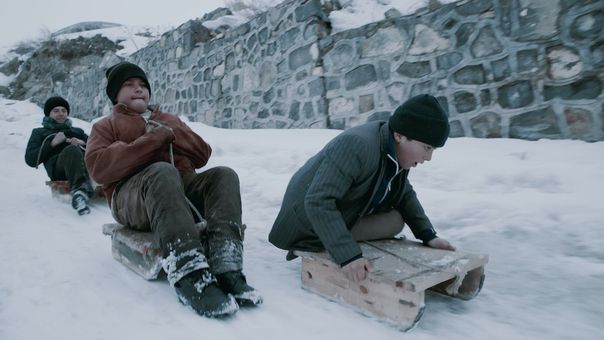On a Quest for Black Gold
By Monty Majeed
"I wish I was an oven and you would heat me like coal," says 12-year-old Gurbuz, the chubby and mischievous back-bencher, to his classmate, the beautiful Ebru, in a love letter he writes to her.

This sentence encompasses the true spirit of Turkish filmmaker Faruk Hacıhafızoğlu's debut feature SNOW PIRATES (KAR KORSANLARI, Turkey, 2014), part of this year’s Berlinale Generation Kplus. Like the three main protagonists of the film, Gurbuz, Serhat and Ibrahim, every child growing up in Kars in the 1980s knows the real value of coal. It is more than just a beautiful metaphor for them. It stands for survival. With the harsh winters taking a toll on their lives, it is their most prized possession. And thanks to the curfew imposed due to the military coup d'etat, and the corruption in the system, it has become almost unattainable for poor families in their neighbourhood.
None of this stops these boys from setting out on an adventure hunting for black gold in the endless sea of snow. And nothing can discourage Gurbuz from pursuing Ebru, who doesn't even take a second to reject his invite to a date. Hacıhafızoğlu's protagonists are filled with hope, optimism and cheer even when the going is tough. Neither the bleak weather nor the authoritarian ways of their schoolteachers bog them down. The bad news pouring out of radio sets seem irrelevant to them when they face immediate problems like the peeling plaster of the walls and empty stoves in their homes. They find happiness in small things, be it reading a comic book under the table, walking like ducks on the snow or sledding at high speed down the many snow ramps. Their main source of entertainment is Serhat’s retelling of the tall tales from the movies he watches on the tiny black-and-white television at a neighbour's house and they picture themselves as superheroes of their own fantasies.
Unlike most coming-of-age stories, the beauty of SNOW PIRATES lies in the fact that Hacıhafızoğlu manages to retain this spirit of optimism right until the end, in a way, compensating for the lack of colours in the landscape. This also ensures that the film never becomes preachy in its approach. The static shots elegantly photographed by Turksoy Golebeyi sucessfully bring out the contrast between the uneventful and oppressed life in the neighbourhood and the vigour of the boys who inhabit it. What, however, doesn't work for the film is the scant use of background score which slows it down in parts and does not match up with the light-hearted and energetic performances that the young actors deliver.

